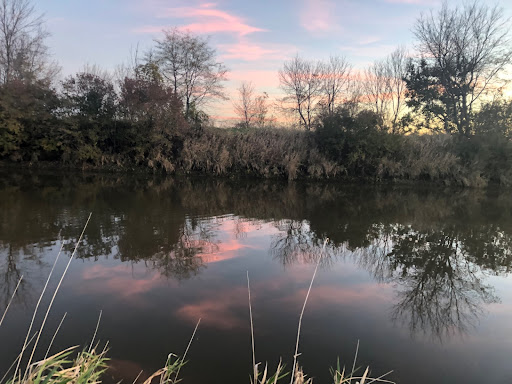Winter is coming: How different animals prepare for Winter

The Amana Lily Pond on a brisk fall thursday afternoon.
December 3, 2021
Fall is a universal time of change. When the leaves become colorful and animals scurry to prepare for the winter. Autumn is the tranquil time of transition from the warmth of summer to the freezing cold of winter, Leaves turning beautiful colors and then dropping from the trees, and birds begin to prepare for their migrations south.
Geese flying south in that classic V formation is something most are familiar with. There are over 350 migratory species of birds in North America, some of them migrate between elevations and only travel a few miles, others travel large distances that span entire continents.
Birds travel for a variety of reasons, mostly having to do with changing resources. When the food supply begins to decline in late summer and autumn, the birds travel south where there is a much more sustainable food source.
Other species may migrate annually to mate, and lay eggs. The location of a bird’s breeding zone can also contribute to this, according to Writer and Birder Melissa Mayntz, “The farther north a bird’s breeding range is located, the later its mating season will begin. These birds might migrate earlier because they have greater distances to travel to reach their ideal breeding locations.”
The Rufous hummingbird, for example, makes one of the longest migrations of any hummingbird species. This small, stout bird may seem unassuming if you come across it in your backyard, but this bird has made an unbelievable journey. Every year the Rufous Hummingbird flies 4000 miles from their winter homes in Northern Mexico to their breeding ground on the southern tip of Alaska.
Though most birds spend most of late summer and autumn traveling to their wintering ground, Bears spend this time preparing to stay put. Before Hibernation, bears spend fall eating and drinking almost non-stop, this process is called hyperphagia. While in the state of hyperphagia, bears can gain upwards of 1000 lbs, or around 450 Kilograms.
They also prepare by making dens. Bears make dens in a variety of locations, from tree logs to caves and rock crevices. Female bears who are pregnant will give birth within a few months of hibernation starting, she will nurse the cubs for the duration of her time in the den. When hibernation ends, bears exit their dens (Female bears accompanied by their cubs) and they are ravenous but luckily there is plenty of food. Melting snow has revealed the nutrition filled vegetation and deer and other animals are easy pickings.
While bears spend most of the fall preparing by just eating, other animals, such as the Squirrel also store surplus food for the winter. Only Ground squirrels have to hibernate, grey squirrels (Who live in the tree’s) make nests in trees and store their food in shallow holes nearby. Throughout the winter they reside in their nests full time, they only leave in the early morning and evening to get food. During the winter, several squirrels may cohabitate in the same den, this is done in order to preserve as much warmth as possible during these cold months.
Though fall is one of the shorter seasons, it gives animals the essential time allotted to prepare for the coming winter.







